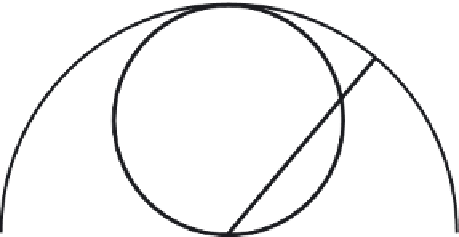Biology Reference
In-Depth Information
FIGURE 4.11
The relationship of
Kendall's shape space to the space of
aligned triangles scaled to unit centroid size.
The outer semicircle is the cross-section of
the space of aligned triangles scaled to unit
centroid size, as in
Figure 4.10
. The inner cir-
cle is a cross-section through Kendall's
shape space, which is the sphere of aligned
triangles scaled to cos(
(0, 1)
A
B
). Kendall's shape
space has a radius of one-half. Points
ρ
A
and
ρ
B
represent the same shape at
CS
5
1 and
CS
5
cos(
ρ
), respectively.
(
1, 0)
(1, 0)
(0, 0)
Because cos(
ρ
) decreases as
ρ
increases, scaling each configuration in the shape space to
ρ
ρ
cos(
is its distance from the reference) produces a new shape space sphere with
a radius of 1/2, tangent to the previous shape space at the reference shape (
Figure 4.11
).
This new space is
Kendall's shape space
for triangles; it is the set of centered shapes in which
each is at the size and orientation that minimizes its distance from the reference. It may
appear that Kendall's shape space is dramatically different from the previous shape space,
but certain key properties remain the same. One of these properties is the distance of the
target shape from the reference shape across the surfaces of the shape spaces. In the first
shape space, the distance of the target from the reference was
) (where
, the angle subtended by
the arc. In Kendall's shape space, the angle subtended by the arc is now 2
ρ
ρ
, but the radius
is 1/2, so the arc length is 2
/2. Although distances between the reference and the targets
are not altered, distances between targets are (
Slice, 2001
). Another key property that
remains the same is the number of dimensions. In the transition between shape spaces, the
constraint on centroid size was changed; in Kendall's shape space the constraint is cos(
ρ
)
instead of one. This still specifies a single value for each shape; configurations that differ
only in size are represented by a single point in Kendall's shape space. Thus, Kendall's
shape space for triangles is also the two-dimensional surface of a three-dimensional
sphere.
For configurations of landmarks that are more complex than triangles, we can apply the
same set of operations to move from pre-shape space to the two shape spaces. Regardless
of the number of landmarks and the number of coordinates of those landmarks, the transi-
tions involve: (1) selecting the rotations that are at the minimum distance from the refer-
ence in pre-shape space, and (2) finding the centroid sizes that fully minimize the distance
from the reference. Describing the geometric relationship of these spaces at higher dimen-
sions is rather demanding (
Small, 1996
), but near their poles (i.e. near the reference config-
urations) these spaces are expected to have similar properties to the spaces for triangles
(
Slice, 2001
).
Kendall's shape space and all of the spaces described above are curved, non-Euclidean
spaces. This is important because the conventional tools of statistical inference assume a
linear, Euclidean space. Consequently, we cannot use those tools to analyze shapes in
Kendall's shape space. Much of Kendall's own work concerns statistical inference within
the curved space that bears his name, but most biologists do not need to work in that
ρ









